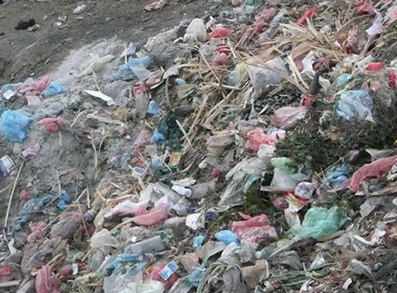7.2 Physical nature of the pollutant
Pollutants may be in the form of gas, liquid, solid or energy.
What polluting gases can you think of?
Greenhouse gases are pollutants that contribute to human-induced climate change (mentioned in Study Session 1). The main greenhouse gases are carbon dioxide, methane and nitrogen oxides.
Liquid pollutants usually come from liquid waste. Liquid waste includes human excreta (both faeces and urine), industrial wastewaters and other forms of waste from water-using activities (Figure 7.2). Factories generate liquid waste from activities related to washing in the manufacturing process, cleaning objects and chemical mixing. Sewage is a mixture of human excreta from water-flushed toilets and other wastewater from houses and businesses. Sewage and human waste from overflowing septic tanks and latrines are frequent sources of pollution.

Urban run-off is another type of liquid waste that can cause pollution. Rainwater washes many different types of waste from the land surface into lakes and rivers. Urban run-off can contain a lot of organic matter. This may come from open defecation or inappropriate handling of organic wastes produced from households and businesses. Organic matter includes anything that is derived from living organisms, such as human and animal wastes, decaying plants and food wastes.
Pollutants also come in solid form. Plastic bags are one of the most common solid wastes. Solid waste is any solid material that is assumed not to be useful and is therefore thrown away. Factories, businesses and households produce different kinds of solid waste such as paper, plastics, metals, chemicals in solid form, pieces of cloth or food and animal remains (Figure 7.3). Sometimes you may have observed faecal matter discarded with solid waste, which adds to the problems.

There is a fourth type of pollution that is common in urban communities. This is energy in the form of noise pollution. Noise pollution means unacceptable levels of noise in work, residential and recreational places. Noise makes it difficult to have a conversation and also irritates and disturbs us and in the long term can damage our hearing. Loud music from music shops and clubs in an urban community is a known source of noise disturbance. Such noise may please some, but it disturbs many other people because it interferes with communication in the daytime and sleeping at night.
7.1 What is pollution?
